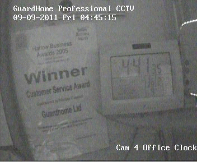In part one of this short series, we explored the workings of infra-red cameras and in the second part we looked at infra-red illuminators. In this final part we shall discuss low light level cameras.
Modern cameras can provide perfectly good colour images in extremely low light levels. How often has a game of cricket been stopped due to bad light when the television images seem to show perfectly good light? High speed digital signal processors (dsp’s) allow camera designers to artificially process images to give the appearance of operating in conditions of almost total darkness. This apparently impossible trick can be achieved by accumulating the light from an image over a period of time and then adding it all together. This is little like leaving the shutter open on a conventional camera to capture the faint light from a distant star.
Of course, as it becomes increasingly darker the delay needed to accumulate enough light increases, so again these cameras automatically switch from colour to black and white and also incorporate the infra-red components to enhance the quality of these images. Images continue to be captured beyond the point when the human eye can make out any detail.
Perfectly good images can be captured with nothing more than moonlight. Beyond this point the quality of the images dramatically deteriorate and soon become unusable. If there is sufficient natural or artificial light, the quality of these images are far superior to those produced under infra-red illumination for the reason explained in part 2 of this series. This is particularly true for pan tilt zoom (PTZ) cameras. These are cameras that can sweep a scene on both the horizontal (pan) and vertical (tilt) planes to provide panoramic surveillance of large areas. To provide infra-red illumination for these cameras tends to be quite complicated, bulky and expensive. The image below is taken with a low light level PTZ camera with nothing more than the street light that you see in the image.

The final image below is taken indoors with a low light level camera, with no additional artificial lighting. Although the image is a bit grainy, the time on the clock can be seen and much of the wording on the certificate can be read.

What we have tried to illustrate with this short series is that the selection of the type of camera to use is very much dependant on the range of lighting conditions that is available at all times. It is only when this is taken into consideration in the system design can a CCTV surveillance system deliver images at all times of the day and night. Of course these are not the only factors that determine which camera to use. There are also other lighting conditions such as car headlights or backlighting, as well as environmental factors, that can have equally dramatic effects on the quality of the images.
At GuardHome we understand the impact of these variables and design each CCTV surveillance system around the specific needs of the client and the full range of conditions under which the system will be used. That is why we like to use our tag line Secure By Design

